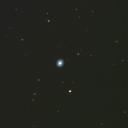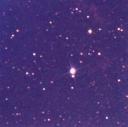The sky was clear all day, but I was worried that if I couldn’t get the mount to track I might miss a clear night. I visited a local auto repair shop in my lunch break and bought a tub of general purpose grease. The operating temperatures are -25 to +150 degrees C. Some articles on the subject of (re)greasing the EQ6 recommend special grease with operating temperatures as low as -50 degrees but I was limited by what was available to me.
I stripped the RA axis whilst cooking our evening meal, so that after eating I could get on with applying the grease. To my surprise when I lifted the lid the grease was very dark in colour and I couldn’t help but laugh at the irony. Most people strip out the black (marmite) grease that used to come packed into the EQ6 gears and replace it with nice white synthetic grease, but I was replacing the white with the black.
Anyway, the point is whatever grease you use there should be enough to pack the bearing and tapered bearings at the base of the RA shaft were nearly grease free.
I stripped the shaft down as far as the worm and cleaned and regreased this, I then reassembled the mount and packed the tapered bearing before carefully inserting it back onto the RA shaft without getting black slime over everything. The operation complete I tightened the retaining bolt and the locking grubs.
Now for the fine tuning. I left the allen bolts finger tight on the worm housing and powered the mount. Performing a slew from left to right at speed 8 was accomplished without any unwanted grinding sounds so I slowed the mount down to 5 and tried again. It took a while before I realized the mount was moving – it’s very quiet now! I carefully tightened the allen bolts that hold the worm casing in place and tightened the small grub screws until they touched the internal stops. I didn’t want to apply any unnecessary pressure to the worm.
With the mount slewing I applied more pressure to the allen bolts until all were tight without. Next step – test it!
Imagine my disappointment when I finally carried the mount to the garden to find a number of large clouds rolling overhead. But I’m not easily put off and set everything up as there were gaps in the clouds so at least I’d get a chance to have another look at the comet.
I n-star aligned on mirfak, almach and algol which are all in the vicinity of comet Holmes(17P). I was trying not to slew the mount too far incase there was too much play in the RA axis. A goto on the comet put it just off centre and I started imaging my first sequence while I went indoors to take the controls remotely from a warm room.
The first and third images are stacked from 12 second exposures, the middle image is a stack of 2 second exposures to allow me to compare it with yesterdays results. No greenish hue visible today, infact I’d say more red if anything. The images have been stacked in registax with darkframe extraction but no post processing has been done on these.
I think my results are improved over yesterdays as I stacked the images by selecting a faint star rather than the comet as my alignment point.
I’ve just returned from realigning the scope in a westerly direction, Vega, Altair and Daneb as my 3 star alignment by the clouds seem to be getting worse. I want to see if there’s any improvement in the tracking now that the RA axis is properly lubed, but I may have to wait for another clear night before I have a chance to test this properly.








